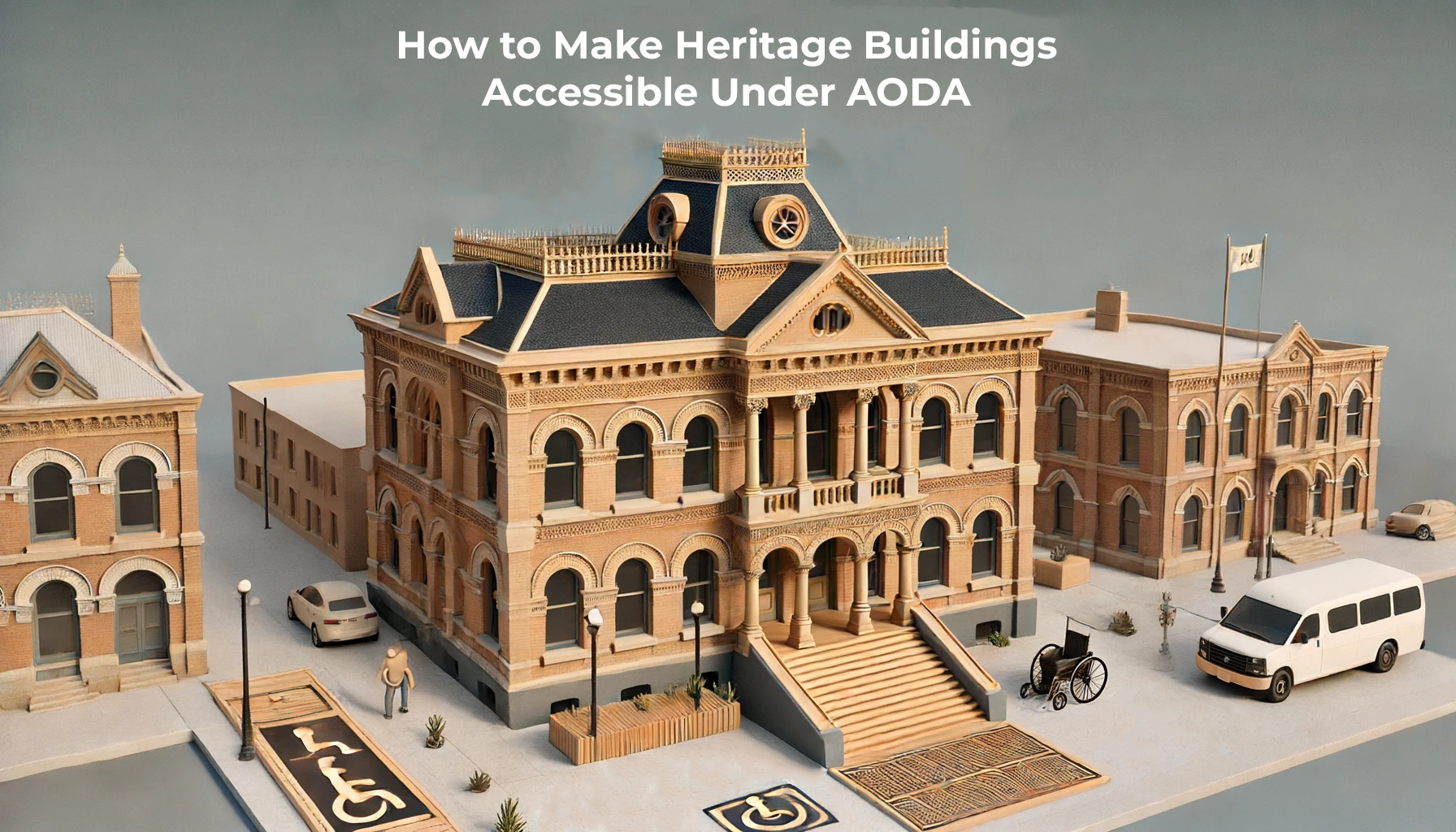Solutions to make heritage accessible buildings, compliant under AODA
In today’s rapidly evolving urban landscape, the integration of accessible features into new and modern buildings has become a standard practice. However, there is often a significant gap in this progressive approach when it comes to our cherished heritage buildings. These historical structures, rich with cultural and architectural significance, frequently lag in accessibility. As we strive for a more inclusive society, it is crucial to explore and implement innovative solutions that make these historic buildings accessible to everyone.
AODA Standards in the Built Environment
The Accessibility for Ontarians with Disabilities Act, otherwise known as the AODA, is an accessibility law based in Ontario, Canada, and it regulates standards across government, public, and private sectors. It was enacted in 2005 to create a barrier-free Ontario by 2025.
Accessibility in the built environment begins with design. This involves thoughtful consideration of features such as ramps, elevators, door widths, and accessible washrooms. Moreover, attention to details like signage, lighting, and acoustics significantly impacts the user experience for individuals with disabilities. Under the AODA, accessible design for the built environment is governed under the Design of Public Spaces Standards.
Accessibility Challenges in Heritage Buildings
Historic buildings and places are a significant asset, a unique and irreplaceable resource, which reflects a rich and diverse expression of past societies and forms an integral part of local, regional, and national cultural identity. For some people, barriers exist which make visiting and using historic buildings and places difficult or sometimes impossible. Making the built heritage more accessible in an appropriate and sensitive manner can increase awareness and appreciation of its cultural, social, and economic value. This important work assists in meeting society’s requirement to protect its architectural heritage, while also meeting the need to provide equal access for all, if possible.
The largest challenge in making heritage-accessible buildings is finding the right balance between architectural conservation and universal design. Few historic buildings and places were designed to be accessible, so they might not seem as challenging to access easily and independently. However, some historic sites, such as castles and military forts, were actually designed and built to make access difficult, which is one reason they are especially interesting..
The implementation of flexible, non-physical arrangements and initiatives within a building to accommodate people with a diverse range of needs is very important. Sometimes, it’s not possible to provide physical access to all parts of a historic building without causing significant damage to its architecture. In such cases, the services or experiences provided should, wherever possible, be made available in an accessible part of the building.
Determining the extent of accessibility improvement and the approaches to be used requires an acceptable balance between the need to protect the qualities of the building, townscape or landscape that are valued and the need to provide for greater social inclusion and access. In making decisions about intervention and change, owners or custodians should respond to the needs of today while being mindful of their role as temporary custodians of heritage passed down from previous generations, which should be passed on to future generations with its special qualities intact.
Planning for Accessibility Upgrades in Heritage Buildings
There is no one-size-fits-all approach to successful accessibility planning. Whatever its size or resources, every heritage organization needs to develop an accessibility planning process that reflects its character and needs. Through this process, your organization can gather the information it needs to prepare an accessibility plan.
Depending on their respective needs and capabilities, some heritage organizations develop accessibility plans that are long and fairly complex, while others develop short and simple plans. The main thing is to prepare a thoughtful plan that leads to real improvements in accessibility and accommodation at your organization.
Here is a general step-by-step approach to accessibility planning, which you can adapt to suit your organization’s needs and resources:
-
- Appoint an Accessibility Coordinator: One person in your organization should have responsibility for coordinating your accessibility planning process for a period of time. This will help to ensure consistency and avoid the repetition of work. The coordinator takes the lead in:
- Organizing the initial accessibility planning process and preparing your organization’s accessibility plan.
- Establish contacts with local disability groups and people with disabilities who are willing to help your organization identify barriers and decide how to address them.
- Ensuring that the plan’s accessibility strategy and projects are carried out.
- Monitoring progress and updating the plan, usually on an annual basis.
- Create an Accessibility Work Group: Your organization may also want to establish an Accessibility Work Group to assist the coordinator. Members of the workgroup should be committed to making accessibility a high priority in their respective areas of your organization. The workgroup may include organization staff, volunteers, and people with personal or professional knowledge of disability issues and barrier removal.
- Create and Distribute a Mission Statement: A mission statement serves to announce the accessibility planning process and explains the purpose and goals of the work. A strong mission statement helps build commitment to improving accessibility throughout the organization. Once the objective or mission statement is approved and endorsed by your organization, distribute it widely among staff, volunteers, supporters, public institutions, etc.
- Review Past Initiatives and Successes: If your organization has had previous experience with accessibility planning and projects, evaluate what has been accomplished to date. Organizations that lack such experience can still benefit from reviewing any informal or situation-specific responses to disability issues in the past.
- Identify Barriers: With input from disability groups and people with disabilities, identify as many barriers and potential barriers as possible. Barriers tend to interconnect, so by identifying as many of them as possible enables you to take a more structured, logical approach to their removal.
- Establish Priorities for Barrier-Free Accessible Parking: Seek help from disability groups and people with disabilities to determine which barriers your organization should tackle first, based on their impact and severity. The most serious barriers identified should have top priority, even if it requires working in phases over several years. Take time to think through the implications and consequences of removing a particular barrier. You don’t want to inadvertently create a new barrier in its place.
- Develop a Strategy for Barrier Removal and Prevention: Your strategy may include some or all of the following elements:
- Identify the barriers selected for priority action, the methods that will be used to address them, and the intended outcomes.
- Determine how much time that staff and volunteers will need to give each barrier removal initiative, and whether external experts may be required (e.g., architects, consultants, specialists in relevant fields such as Web design).
- Develop performance criteria that can later be used to measure the effectiveness of each initiative. Criteria should be clear and verifiable.
- Specify who will have lead responsibility for each initiative.
- Develop a timeline for implementing each initiative in consultation with all those responsible.
- Identify the financial and related costs of each initiative, with respect to staff time and other resources. Some initiatives may involve little cost; others may require a significant investment that will need to be figured into the annual planning and budget cycles.
- Decide How to Monitor Your Progress: Effective monitoring may be accomplished through:
- Regular meetings of the coordinator and those with lead responsibility for implementing specific projects.
- Community feedback.
- Suggestion boxes, questionnaires, surveys, and similar tools, may help to obtain feedback from visitors and the larger community.
- Appoint an Accessibility Coordinator: One person in your organization should have responsibility for coordinating your accessibility planning process for a period of time. This will help to ensure consistency and avoid the repetition of work. The coordinator takes the lead in:
- Create and Finalize the Accessibility Plan: Here are the steps to drafting and finalizing your plan:
- Give a draft version of the plan to all those who contributed significantly to its content. After incorporating their comments and suggestions, prepare a final draft.
- Have the plan reviewed and approved by your organization’s executive. Plans developed jointly with other organizations need to be approved by all the organizations involved.
- Make the plan available to your organization. You may also choose to make it available to the wider community by posting it on your website, announcing its availability in your newsletter, etc.
- Make the plan available to community members upon request and, if resources permit, in alternative formats.
- Monitor and Review Your Progress: Accessibility planning is an ongoing process that takes time, patience, and continued effort. Your accessibility plan should be revised and updated annually to register achievements and set new goals for improving accommodation and access.
Actions to Ensure AODA Compliance in Heritage Buildings.
It’s important to get the right advice from the start when improving the accessibility of a historic building or place. Good and timely advice often results in simpler, more cost-effective solutions, involving creative approaches that deliver high quality design in projects requiring physical interventions.
Contacting a professional consultant to conduct an accessibility audit is the first step. A consultant with recognized experience and qualifications in architectural conservation and accessible design is a valuable asset in this case.
An AODA accessibility audit of a service, building or place is an important tool in identifying and documenting the barriers that can cause difficulties for people with physical, sensory or intellectual disabilities. It identifies where such barriers may compromise access and it measures the usability of facilities and services being delivered. The audit generally follows the normal journey sequence of the user. However, this depends on the type of place being audited. It may typically include an assessment of all or some of the following:
- Pre-visit information
- Approach routes to the site
- Off & on-street car parking
- Accessible paths, surfaces, methods of movement, and wayfinding
- Entry/Exit to any buildings
- The facilities, services, and information within the building
- Communications systems and signs
- Procedures for emergency situations and evacuation
Conclusion
In conclusion, ensuring heritage-accessible buildings is not just a matter of compliance with modern standards; it is a commitment to inclusivity and cultural preservation. By thoughtfully integrating accessibility features, we can open the doors of our historical treasures to everyone, allowing all individuals to appreciate and engage with our shared heritage. This endeavor requires a delicate balance between maintaining architectural integrity and meeting contemporary needs, but with innovative solutions and a collaborative approach, it is entirely achievable. As we move forward, let us prioritize making heritage sites accessible, honoring both our past and the diverse community that forms our present and future.
We at Accessibility Partners Canada prioritize inclusivity in the built environment and look forward to paving the way for a more equitable and vibrant society, where every individual can participate fully and independently. Together, let us continue to champion accessibility and build a future where every individual is valued, respected, and included.
Solutions to make heritage buildings compliant under AODA
In today’s rapidly evolving urban landscape, the integration of accessible features into new and modern buildings has become a standard practice. However, there is often a significant gap in this progressive approach when it comes to our cherished heritage buildings. These historical structures, rich with cultural and architectural significance, frequently lag in accessibility. As we strive for a more inclusive society, it is crucial to explore and implement innovative solutions that make these historic buildings accessible to everyone.

